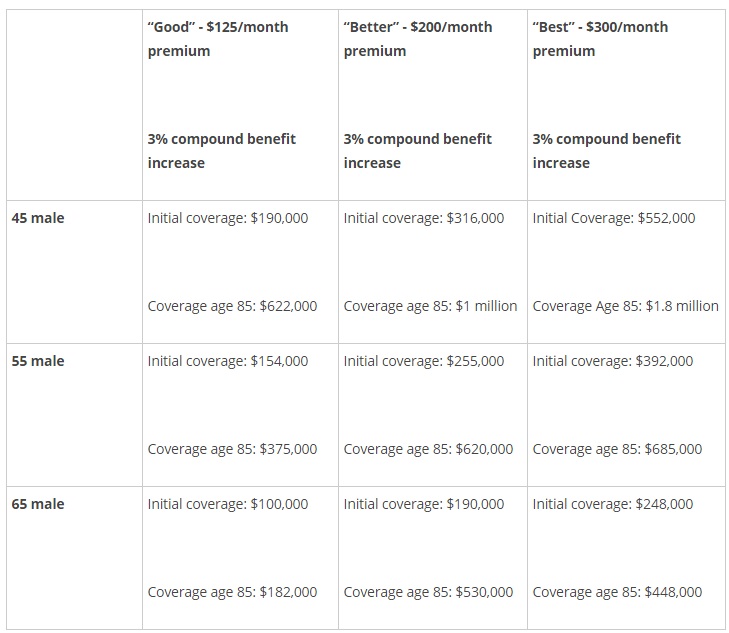The Advisor's View of Long-Term Care Planning
Never miss any update
Subscribe to the Advisor's View of Long-Term Care Planning newsletter today to receive updates on the latest news from our carriers.
Your privacy is important to us. We have developed a Privacy Policy that covers how we collect, use, disclose, transfer, and store your information.
Why a premium-first approach for presenting LTC may be most effective

“What’s the premium?”
One of the services we offer is providing rate illustrations for insurance advisors. An advisor who may only write a couple of LTCI policies or long-term care (LTC) hybrid policies per year often contacts us because a client has asked for information about LTC planning products, including that all important question above.
The advisor will tell the client about the premium — and rightfully so — “It depends.” The advisor may explain some of the reasons why people buy LTC coverage, the cost of long-term care (using cost-of-care surveys), and how LTC products are underwritten. The advisor may discuss standalone LTCI, and also linked products, or life insurance products with riders.
Once we bring the case back to our office, we will compare various companies and then make a recommendation based on the information provided by the financial advisor.
We are not unlike many BGAs providing this service. For many years, it has been a method that has served both the carriers and the advisors well. However, beginning a couple of years ago, the model wasn’t working as well. Consumers were still interested in LTCI, but they weren’t buying at the same rate. In fact, the ratio of proposals to sales went down by 50 percent at our company and others. What happened?
What happened was premium price resistance. The old plans that were designed using the private cost of nursing home care, and a home-care benefit that was the same as that for nursing home care, with a three-year benefit period, and 5 percent automatic inflation coverage.
Ten years ago, this type of plan design had a premium level attractive to the buyer. Today, the same plan design presents a premium that is not attractive. And it isn’t valid to assume that, simply because your clients are wealthy enough to pay high premiums, they are willing to do so.
So what’s the answer? Our suggestion is to try something different and switch the order of the sales conversation. Instead of leading with plan design and then determining premium, state the desired premium-first and start searching for a plan design that fits the premium.
Of course, this is the approach that people use when buying a home or a car. They have a budget number in mind and then find the best fit for them based on that budget. Auto advertisements are loaded with reminders of monthly lease payments costs—often as the first item mentioned in the ad.
What about a sales strategy that doesn’t take this approach, like when a salesperson makes you wait to find out the price of a product or service?
I can think of two great examples of these—infomercials and timeshares.
If you’ve ever had the unfortunate experience of sitting through a sales pitch on either one, you’ll know that you will have to sit through an extended period of time hearing about the product features before you’ll find out the price.
A lot of “how much would you pay” questions before you are “ready” to be made aware of the price.
This approach just doesn’t work. If you attempt to do this, the only thing going through the clients' mind will be, “How much does this cost?” and they won’t be able to hear anything else that’s being said until you provide that information.
Of course, long-term care insurance is not like other products—it’s a financial protection product.
However, if we look at other financial protection products, we find a similar approach works. For example, those looking at investing will need to determine what can be set aside—then determine an investment approach. The biggest direct sellers of term life insurance that sell online talk about how affordable term life insurance is—the fact that a person who is 50 years old can buy a quarter million of term life insurance for $22 per month. They know a premium-first approach works.
LTC insurance carrier research using simulated sales situations has shown the most effective sales approach is also the premium-first approach. These research examples use a controlled randomized trial to determine the best way to get people to show interest.
How to implement a premium-first approach
To implement a premium-first approach, try creating a “sample rate sheet” that offers a good, better, best approach to plans. By offering three plans and some age brackets, buyers can instantly see that there is a plan that will fit for them.

If you have this ready, then you can always relieve the anxiety someone has when shopping for LTC coverage—the interested party will see that, for a 55-year-old, $200 per month will get them about $250,000 of LTC coverage. Once they determine a premium amount you can search for the perfect carrier based on benefits and health.
The key is the speed of the information your client is really seeking—don’t make someone interested in LTC wait for a premium number. Get their budget, let them know that they can work with it, and work from there to close the sale.
